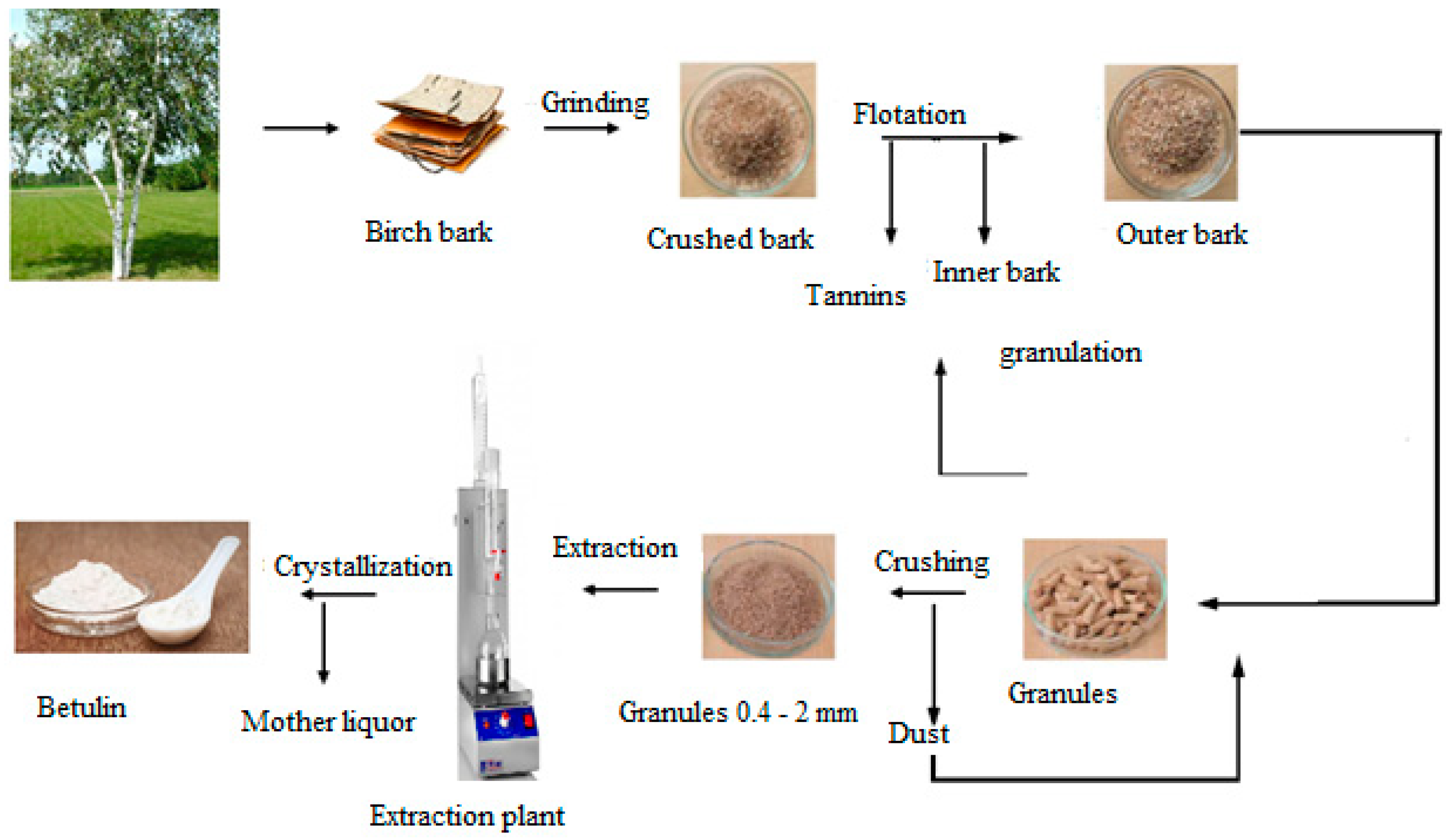Methods of Betulin Extraction from Birch Bark
Abstract
1. Introduction
2. The Prevalence of Betulin in Nature
3. Methods of Betulin Isolation
- (a)
- Birch bark is treated with water–alcohol alkali (alcohol: MeOH, EtOH, i-PrOH);
- (b)
- Removal of acids and other impurities with Ca(OH)2;
- Removal of lupeol by benzene extraction;
- Recrystallization from ethanol;
- Removal of residual (partially colored) impurities on silica gel in chloroform;
- Recrystallization from ethanol solution.
- To ensure the selectivity of extraction, while first of all excluding the extraction of polar satellites (sugars and phenols);
- The use of inexpensive and environmentally friendly reagents and solvents in the process of obtaining pure betulin.
4. Conclusions
Author Contributions
Funding
Conflicts of Interest
Sample Availability
Appendix A
References
- Rastogi, S.; Pandey, M.M.; Kumar, S.W. Medicinal plants of the genus Betula: Traditional uses and a phytochemical-pharmacological revie. J. Ethnopharmacol. 2015, 159, 62–83. [Google Scholar] [CrossRef] [PubMed]
- Krasutsky, P.A. Birch bark research and development. Nat. Prod. Rep. 2006, 23, 919–942. [Google Scholar] [CrossRef] [PubMed]
- Bergelin, E.; Holmbom, B. Reactions and distribution of birch extractives inkraft pulp oxygen delignification. J. Wood Chem. Technol. 2008, 28, 261–269. [Google Scholar] [CrossRef]
- Kislitsyn, A.N. Birch bark extractives: Isolation composition, properties, application. Khim. Drev. 1994, 3, 3–28. [Google Scholar]
- Pinto, P.C.R.O.; Sousa, A.F.; Silvestre, A.J.D.; Pascoal Neto, C.; Gandini, A.; Eckerman, C.; Holmbom, B. Quercus suber and Betula pendula outer barks as renewable sources of oleochemicals: A comparative study. Ind. Crop. Prod. 2009, 29, 126–132. [Google Scholar] [CrossRef]
- Hayek, E.W.H.; Jordis, U.; Moche, W.; Sauter, F. A bicentennial of betulin. Phytochemistry 1989, 28, 2229–2242. [Google Scholar] [CrossRef]
- Cîntă Pînzaru, S.; Leopold, N.; Kiefer, W. Vibrational spectroscopy of betulinic acid HIV inhibitor and of its birch bark natural source. Talanta 2002, 57, 625–631. [Google Scholar] [CrossRef]
- Jaaskelainen, P. Betulinol and its utilization. Pap. Ja Puu. 1981, 63, 599–603. [Google Scholar]
- Ramadoss, S.; Siddiqui, M.J.A. Extracting betulinic acid from Ziziphus juiuba. US Patent 6,264,998 B1, 24 June 2001. [Google Scholar]
- Kundu, A.B.; Barik, B.R.; Mondal, D.N.; Dey, A.K.; Banerji, A. Zizyberanalic acid, A pentacyclic triterpenoid of Zizyphus jujube. Phytochemistry 1989, 28, 3155–3158. [Google Scholar] [CrossRef]
- Melek, F.R.; Radwan, A.; Achmed, A.; Aboutabl, E.A. Triterpenes from Atractylis carduus L. Farmazie 1989, 44, 735. [Google Scholar]
- Siddiqui, S.; Siddiqui, B.S.; Naeed, A.; Begum, S. Pentacyclic triterpenoids from the leaves of Plumeria obtuse. Phytochemistry 1989, 28, 3143–3147. [Google Scholar] [CrossRef]
- Sharma, P.P.; Roy, R.K.; Anurag, B.; Gupta, D. Pentacyclic Triterpinoids from Betula utilis and Hyptis suaveolens. Int. J. PharmTech Res. 2010, 2, 1558–1562. [Google Scholar]
- Kovac-Besovic, E.E.; Duric, K.; Kalođera, Z.; Sofic, E. Identification and isolation of pharmacologically active triterpenes in Betulae Cortex, Betula pendula Roth., Betulaceae. Bosn. J. Basic Med. Sci. 2009, 9, 31–38. [Google Scholar] [CrossRef] [PubMed]
- Nick, A.; Wright, A.D.; Rali, T.; Sticher, O. Antibacterial triterpenoids from Dillenia papuana and their structure-activity relationships. Phytochemistry 1995, 40, 1691–1695. [Google Scholar] [CrossRef]
- Fujioka, T.; Kashiwada, Y.; Kilkuskie, R.E.; Cosentino, L.M.; Ballas, L.M.; Jiang, J.B.; Janzen, W.P.; Chen, I.-S.; Lee, K.-H. Anti-AIDS Agents, 11. Betulinic Acid and Platanic Acid as Anti-HIV Principles from Syzigium claviflorum, and the Anti-HIV Activity of Structurally Related Triterpenoids. J. Nat. Prod. 1994, 57, 243–247. [Google Scholar] [CrossRef]
- Zuco, V.; Supino, R.; Righetti, S.C.; Cleris, S.; Marchesi, E.; Gambacorti-Passerini, C.; Formelli, F. Selective cytotoxicity of betulinic acid on tumor cell lines, but not on normal cells. Cancer Lett. 2002, 175, 17–25. [Google Scholar] [CrossRef]
- Del Carmen Recio, M.; Giner, R.M.; Máñez, S.; Ríos, J.-L. Structural requirements for the anti-inflammatory activity of natural triterpenoids. Planta Med. 1995, 61, 182–185. [Google Scholar] [CrossRef]
- Kuznetsova, S.A.; Skvortsova, G.P.; Maliar, I.N.; Skurydina, E.S.; Veselova, O.F. Extraction of betulin from birch bark and study of its physico-chemical and pharmacological properties. Rus. J. Bioorg. Chem. 2014, 40, 742–747. [Google Scholar] [CrossRef]
- Fǎlǎmaş, A.; Pînzaru, C.; Dehelean, C.A.; Peev, C.I.; Soica, C. Betulin and its natural resource as potential anticancer drug candidate seen by FT-Raman and FT-IR spectroscopy. J. Raman Spectrosc. 2011, 42, 97–107. [Google Scholar] [CrossRef]
- Alakurtti, S. Synthesis of Betulin Derivatives against Intracellular Pathogens. Ph.D. Thesis, VTT Technical Research Centre of Finland, University of Helsinki, Helsinki, Finland, 2013. [Google Scholar]
- Ferreira, R.; Garcia, H.; Sousa, A.F.; Freire, C.S.R.; Silvestre, A.J.D.; Rebelo, L.P.N.; Pereira, C.S. Isolation of suberin from birch outer bark and cork using ionic liquids: A new source of macromonomers. Ind. Crop. Prod. 2013, 44, 520–527. [Google Scholar] [CrossRef]
- Šiman, P.; Filipova, A.; Ticha, A.; Niang, M.; Bezrouk, A.; Havelek, R. Effective method of purification of betulin from birch bark: The importance of its purity for scientific and medicinal use. PLoS ONE 2016, 11, 1–14. [Google Scholar] [CrossRef]
- Hu, Z.; Guo, N.; Wang, Z.; Liu, Y.; Wang, Y.; Ding, W.; Zhang, D.; Wang, Y. Development and validation of an LC-ESI/ MS/MS method with precolumn derivatization for the determination of betulin in rat plasma. J. Chromatogr. B Anal. Technol. Biomed. Life Sci. 2013, 939, 38–44. [Google Scholar] [CrossRef] [PubMed]
- Holonec, L.; Ranga, F.; Cranic, D.; Truta, A.; Socaciu, C. Evaluation of betulin and betulinic acid content in birch bark from different forestry areas of western carpathians. Not. Bot. Horti Agrobot. Cluj-Napoca 2012, 40, 99–105. [Google Scholar] [CrossRef]
- O’Connell, M.M.; Bentley, M.D.; Campbell, C.S.; Cole, B.J.W. Betulin and lupeol in bark from four white-barked birches. Phytochemistry 1988, 27, 2175–2176. [Google Scholar] [CrossRef]
- Yin, J.; Ma, H.; Gong, Y.; Xiao, J.; Jiang, X.; Zhan, Y.; Li, C.; Ren, C.; Yang, Y. Effect of MeJA and Light on the Accumulation of Betulin and Oleanolic Acid in the Saplings of White Birch (Betula platyphylla Suk.). Amer. J. Plant Sci. 2013, 4, 7–15. [Google Scholar] [CrossRef]
- Jager, S.; Laszczyk, M.; Scheffler, A. A preliminary pharmacokinetic study of betulin, the main pentacyclic triterpene from extract of outer bark of birch (Betulae alba cortex). Molecules 2008, 13, 3224–3235. [Google Scholar] [CrossRef]
- Ferreira, R.; Garcia, H.; Sousa, A.F.; Freire, C.S.R.; Silvestre, A.J.D.; Kunz, W.; Rebelo, L.P.N.; Pereira, C.S. Microwave assisted extraction of betulin from birch outer bark. RSC Adv. 2013, 3, 21285–21288. [Google Scholar] [CrossRef]
- Orsini, S.; Ribechini, E.; Modugno, F.; Klügl, J. Micromorphological and chemical elucidation of the degradation mechanisms of birch bark archaeological artefacts. Herit. Sci. 2015, 3. [Google Scholar] [CrossRef]
- Shai, L.J.; McGaw, L.J.; Aderogba, M.A.; Mdee, L. Four pentacyclic triterpenoids with antifungal and antibacterial activity from Curtisia dentata (Burm.f) C.A. Sm. Leaves. J. Ethnopharmacol. 2008, 119, 238–244. [Google Scholar] [CrossRef]
- Machado, K.E.; Filho, V.C.; Cruz, R.C.B. Antifungal activity of Eugenia umbelliflora against dermatophytes. Nat. Prod. Commun. 2009, 4, 1181–1184. [Google Scholar] [CrossRef]
- Innocente, A.; Casanova, B.B.; Klein, F.; Lana, A.J.D. Synthesis of isosteric triterpenoid derivatives and antifungal activity. Chem. Biol. Drug Des. 2014, 83, 344–349. [Google Scholar] [CrossRef] [PubMed]
- Eckerman, C.; Ekman, R. Comparison of solvents for extraction and crystallisation of betulinol from birch bark waste. Paperi Ja Puu. 1985, 3, 100–106. [Google Scholar]
- Pinzaru, S.C.; Dehelean, C.; Soica, C.; Culea, M. Evaluation and differentiation of the Betulaceae birch bark species and their bioactive triterpene content using analytical FT-vibrational spectroscopy and GC-MS. Chem. Cent. J. 2012, 6, 1–12. [Google Scholar] [CrossRef]
- Nurmesniemi, H.; Mäkelä, M.; Pöykiö, R.; Manskinen, K.; Dahl, O. Comparison of the forest fertilizer properties of ash fractions from two power plants ofpulp and paper mills incinerating biomass-based fuels. Fuel Process. Technol. 2012, 104, 1–6. [Google Scholar] [CrossRef]
- Fan, J.; Luo, Y.; Xie, C.; Song, F. Solubilities of betulin and betulinic acid in sodium hydroxide aqueous solutions of varied mole fraction at temperatures from 283.2K to 323.2K. J. Thermodyn. 2013, 67, 1–4. [Google Scholar] [CrossRef]
- Tretiakov, S.I.; Koptelova, E.N.; Kutakova, N.A.; Bagretsova, N.V.; Voropaeva, N.L. The Study of the Kinetics of Obtaining Betulin and Extractive Substances from the Birch Tree Bark. J. Metastable Nanocryst. Mater. 2017, 29, 42–47. [Google Scholar] [CrossRef]
- Tolstikov, G.A.; Flekhter, O.B.; Shultz, E.E.; Baltina, L.A. Betulin and its derivatives. Chemistry and biological activity. Chem. Interests Sustain. Dev. 2005, 3, 1–30. [Google Scholar]
- Tolstikov, G.A.; Flekhter, O.B.; Shultz, E.E.; Baltina, L.A.; Tolstikov, A.G. Production of betulinic acid from betulin extract. Antiviral and anti-ulcer activity of some related terpenoids. Chem. Pharm. J. 2002, 3, 26–28. [Google Scholar]
- Tolstikov, I.G.; Sorokina, I.V.; Tolstikov, G.A. Terpenoids of the lupan series—biological activity and pharmacological prospects. Bioorg. Chem. 2006, 32, 42–55. [Google Scholar]
- Abyshev, A.Z.; Agaev, E.M.; Huseynova, A.B. Investigation of the chemical composition of birch bark extract Cortex Betula sem. Betulaceae. Chem. Pharm. J. 2007, 41, 22–26. [Google Scholar] [CrossRef]
- Aleksandrovich, L.V.; Vladimirovich, L.A.; Nikolaevich, K.B. Method for Obtaining Betulin (original language Russian). RU Patent 2340624 C1, 10 December 2008. [Google Scholar]
- Galgon, T.; Hoke, D.; Drager, B. Identification and Quantification of Betulinic Acid. Phytochem. Analysis 1999, 10, 187–190. [Google Scholar] [CrossRef]
- Method of betulinol isolation. RU Patent 2002106582/04, 20 June 2003.
- Krasutsky, P.A.; Kolomitsyn, I.V.; Krasutskyy, D.A. Depolymerization extraction of compounds from birch bark. US Patent 8,197,870 B2, 12 June 2012. [Google Scholar]
- Yunusov, M.S.; Komissarova, N.G.; Belenkova, N.G. Method of obtaining betulin and lupeol. RU Patent 2004122279/04, 20 February 2006. [Google Scholar]
- Carlson, R.M.; Krasutsky, P.A.; Reza-Ul Karim, M. Use of betulin and analogs thereof to treat herpesvirus infection. US Patent 5750578-A, 12 May 1998. [Google Scholar]
- Sirotkin, G.V.; Ster nin, Y.I. Method of obtaining betulin. RU Patent 2172178, 20 August 2001. [Google Scholar]
- Sternin, Y.I. Method of obtaining betulin. RU Patent 2192879, 20 November 2002. [Google Scholar]
- Belokon, A.V.; Gezha, E.G.; Pavlenko, A.V.; Zolotarev, V.S. News of Higher Educational Institutions. Caucasian Region. Series “Technical Sciences”; Southern Federal University: Novocherkassk, Russian Federation, 1993; Volume 1, pp. 24–26. [Google Scholar]
- Sauter, M.; Bender, C. Process for obtaining betulin. US Patent 20030153776, 14 August 2003. [Google Scholar]
- Roshchin, V.I.; Shabanova, N.Y.; Vedernikov, D.N. Method of obtaining betulin. RU Patent 2184120, 27 June 2002. [Google Scholar]
- Kislitsyn, A.N.; Slastnikov, I.I.; Trofimov, A.N. Method of betulinol isolation. RU Patent 2138508, 27 September 1999. [Google Scholar]
- Ryazanova, T.V.; Chuprova, N.A.; Kim, N.Y. On the intensification of the extraction process of Siberian larch bark in a disintegrator. Chem. Plant Raw Mater. 2000, 1, 95–100. [Google Scholar]
- Ilyin, S.G.; Malinovskaya, G.V.; Uvarova, N.I.; Elyakov, G.B.; Antipin, M.Y.; Struchkov, Y.T. X-ray analysis of betulafolienetetraol oxide, a triterpene isolated from Betula costata trautv. Tetrahedron Lett. 1982, 23, 5067–5070. [Google Scholar] [CrossRef]
- Chernyaeva, G.N.; Dolgodvorova, S.Y.; Bondarenko, S.M. Extractive Substances of Birch. Krasnoyarsk; Publishing house of the ILiD named after V.N. Sukachev: Krasnoyarsk, Russian Federation, 1986; p. 122. [Google Scholar]
- Nikiforov, D.F.; Butova, O.F. Chemistry and chemical technology of wood. Chem. Wood 1973, 1, 90. [Google Scholar]
- Zhao, G.; Yan, W.; Cao, D. Simultaneous determination of betulin and betulinic acid in white birch bark using PR-HPLC. J. Pharm. Biomed. Analysis 2007, 43, 959–962. [Google Scholar] [CrossRef]
- Takibayeva, A.T.; Demets, O.V.; Zhumadilov, S.S.; Bakibayev, A.A. Derive betulin from kirgyz birch bark (Betula kirghisorum) through alkaline hydrolysis and microwave radiation methods. Rep. Natl. Acad. Sci. Repub. Kazakhstan 2021, 4, 87–92. [Google Scholar] [CrossRef]
- Zhuk, V.V.; Bakibaev, A.A.; Yanovsky, V.A. Investigation of the influence of the nature of extractants in the process of thin-film vapor-phase extraction on the composition, degree of extraction and shape of the products obtained. Bull. Tomsk. Polytech. Univ. 2007, 311, 99–101. [Google Scholar]
- Bakibaev, A.A.; Zhuk, V.V.; Medvedev, D.M.; Yagovkin, A.Y.; Yanovsky, V.A. Method for obtaining extractive substances from birch bark. RU Patent 2298558, 10 May 2001. [Google Scholar]
- Mikhailenko, M.A.; Shakhtschneider, T.P.; Brezgunova, M.E. Obtaining and investigation of physico-chemical properties of betulin solvates. Chem. Veg. Raw Mater. 2010, 2, 63–70. [Google Scholar]
- Koptelova, E.N.; Kutakova, N.A.; Tretjakov, S.I.; Faleva, A.V.; Razumov, E.; Barcík, Š. Extraction of betulin from the birch bark balance at pulp and paper production. Wood Res. 2020, 65, 833–842. [Google Scholar] [CrossRef]
- Zhuk, V.V.; Yanovsky, V.A.; Yanovskaya, E.A.; Bakibaev, A.A.; Andrienko, O.S.; Sharafeev, S.M.; Sachkov, V.I. Recrystallization of betulin extracts from high-boiling hydrocarbon solvents. Chem. Plant Raw Mater. 2012, 2, 73–78. [Google Scholar]
- Yanovsky, V.A.; Andrienko, O.S.; Zhuk, V.V.; Bakibaev, A.A.; Sachkov, V.I. Method of betulin purification. RU Patent 2463306, 10 October 2012. [Google Scholar]
- Zhuk, V.V.; Yanovsky, V.A.; Sambueva, O.B.; Bakibaev, A.A. Technology of betulin production by thin-film vapor-phase extraction. Chem. Plant Raw Mater. 2014, 3, 247–253. [Google Scholar]
- Yogeeswari, P.; Sriram, D. Betulinic acid and its derivatives: A review on their biological properties. Curr. Med. Chem. 2005, 12, 657–666. [Google Scholar] [CrossRef] [PubMed]
- Dehelean, C.A.; Pînzaru, S.C.; Peev, C.I.; Soica, C. Characterization of birch tree leaves, buds and bark dry extracts with antitumor activity. J. Optoelectron. Adv. Mater. 2007, 9, 783–787. [Google Scholar]
- Dehelean, C.A.; Tatu, C.; Simona, C.-P.; Camelia, P.; Codruta, S.; Gabriela, T.; Anghel, S. In vitro studies on mesenchymal stem cells of a dry birch tree bark extract. Toxicol. Lett. 2006, 164, 228. [Google Scholar] [CrossRef]
- Ciurlea, A.S.; Soica, C.; Ionescu, D.; Ambrus, R. Birch tree outer bark, a natural source of bioactive pentacyclic triterpenes with an antitumor activity. J. Agroaliment. Process. Technol. 2010, 16, 328–332. [Google Scholar]
- Şoica, C.M.; Dehelean, C.A.; Peev, C.; Aluas, M.; Zupkó, I.; Kása, P., Jr.; Alexa, E. Physico-chemical comparison study of betulinic acid, betulin and birch bark extract and in vitro investigation of their cytotoxic effects towards skin epidermoid carcinoma (A431), breast carcinoma (MCF7) and cervix adenocarcinoma (HeLa) cell-lines. Nat. Prod. Res. 2012, 26, 968–974. [Google Scholar] [CrossRef]
- Boryczka, S.; Bebenek, E.; Wietrzyk, J.; Kempińska, K.; Jastrzębska, M.; Kusz, J.; Nowak, M. Synthesis, structure and cytotoxic activity of new acetylenic derivatives of betulin. Molecules 2013, 18, 4526–4543. [Google Scholar] [CrossRef]
- Dehelean, C.A.; Soica, C.; Ledeti, I.; Aluas, M. Study of the betulin enriched birch bark extracts effects on human carcinoma cells and ear inflammation. Chem. Cent. J. 2012, 6, 137. [Google Scholar] [CrossRef]
- Drag, M.; Surowiak, P.; Drag-Zalesinska, M.; Dietel, M.; Lage, H.; Oleksyszyn, J. Comparison of the cytotoxic effects of birch bark extract, betulin and betulinic acid towards human gastric carcinoma and pancreatic carcinoma drug-sensitive and drug-resistant cell lines. Molecules 2009, 14, 1639–1651. [Google Scholar] [CrossRef]
- Lugemwa, F.N. Extraction of betulin, trimyristin, eugenol and carnosic acid using water-organic solvent mixtures. Molecules 2012, 1, 9274–9282. [Google Scholar] [CrossRef]
- Boryczka, S.; Michalik, E.; Jastrzebska, M.; Kusz, J.; Zubko, M.; Bębenek, E. X-Ray crystal structure of betulin–DMSO solvate. J. Chem. Crystallogr. 2012, 42, 345–351. [Google Scholar] [CrossRef]
- Ressmann, A.K.; Strassl, K.; Gaertner, P.; Zhao, B. New aspects for biomass processing with ionic liquids: Towards the isolation of pharmaceutically active betulin. Green Chem. 2012, 14, 940–944. [Google Scholar] [CrossRef]
- Chen, Q.; Fu, M.; Liu, J.; Zhang, H.; He, G.; Ruan, H. Optimization of ultrasonic-assisted extraction (UAE) of betulin from white birch bark using response surface methodology. Ultrason. Sonochem. 2009, 16, 599–604. [Google Scholar] [CrossRef] [PubMed]
- Mikhailenko, M.A.; Shakhtshneider, T.P.; Drebushchak, V.A.; Kuznetsova, S.A.; Skvortsova, G.P. Influence of mechanical treatment on the properties of betulin, betulin diacetate, and their mixture with water-soluble polymers. Chem. Nat. Compd. 2011, 47, 229–233. [Google Scholar] [CrossRef]
- Co, M.; Koskela, P.; Eklund-Åkergren, P.; Srinivas, K.; King, J.W.; Sjöberga, P.J.R.; Turner, C. Pressurized liquid extraction of betulin and antioxidants from birch bark. Green Chem. 2009, 5, 668–674. [Google Scholar] [CrossRef]
- Guidoin, M.-F.; Yang, J.; Pichette, A.; Roy, C. Betulin isolation from birch bark by vacuum and atmospheric sublimation. A thermogravimetric study. Thermochim. Acta 2003, 398, 153–166. [Google Scholar] [CrossRef]
- Joshi, H.; Saxena, G.K.; Singh, V.; Arya, E.; Singh, R.P. Phytochemical investigation, isolation and characterization of betulin from bark of Betula utilis. J. Pharmacogn. Phytochem. 2013, 2, 145–151. [Google Scholar]
- Tijjani, A.; Ndukwe, I.G.; Ayo, R.G. Isolation and characterization of lup-20(29)-ene-3,28-diol (betulin) from the stem-bark of Adenium obesum (Apocynaceae). Trop. J. Pharm. Res. 2012, 11, 259–262. [Google Scholar] [CrossRef]
- Vazquez, G.; Gonzalez-Alvarez, J.; Santos, J.; Freire, M.S.; Antorrena, G. Evaluation of potential applications for chestnut (Castanea sativa) shell andeucalyptus (Eucalyptus globulus) bark extracts. Ind. Crop. Prod. 2009, 29, 364–370. [Google Scholar] [CrossRef]
- Chupin, L.; Motillon, C.; Charrier-El Bouhtoury, F.; Pizzi, A.; Charrier, B. Characterisation of maritime pine (Pinus pinaster) bark tannins extractedunder different conditions by spectroscopic methods, FTIR and HPLC. Ind. Crop. Prod. 2013, 49, 897–903. [Google Scholar] [CrossRef]
- Regert, M.; Alexandre, V.; Thomas, N.; Lattuati-Derieux, A. Molecular characterisation of birch bark tar by headspace solid-phase microextraction gas chromatography–mass spectrometry: A new way for identifying archaeological glues. J. Chromatogr. A. 2006, 1101, 245–253. [Google Scholar] [CrossRef] [PubMed]
- Rizhikovs, J.; Zandersons, J.; Dobele, G.; Paze, A. Isolation of triterpene-rich extracts from outer birch bark by hot water and alkaline pre-treatment or the appropriate choice of solvents. Ind. Crop. Prod. 2015, 76, 209–214. [Google Scholar] [CrossRef]
- Pfarr, K.; Danciu, C.; Dehelean, C.; Pfeilschifter, J. Betulin—A plant-derived cytostatic drug—enhances antitumor immune response. J. ImmunoTherapy Cancer 2014, 2, 175. [Google Scholar] [CrossRef][Green Version]
- Maji, A.K.; Maity, N.; Banerji, P.; Banerjee, D. Validated RP-HPLC-UV method for the determination of betulin in Asteracantha longifolia (L.) Nees. extract. Int. J. Phytomed. 2013, 5, 131–135. [Google Scholar] [CrossRef]
- Popov, S.A.; Sheremet, O.P.; Kornaukhova, L.M.; Grazhdannikov, A.E.; Shults, E.E. An approach to effective green extraction of triterpenoids from outer birch bark using ethyl acetate with extractant recycle. Ind. Crop. Prod. 2017, 102, 122–132. [Google Scholar] [CrossRef]
- Ikan, R. Natural Products: A Laboratory Guide, 2nd ed.; Academic Press: London, UK, 2013. [Google Scholar]
- Grazhdannikov, A.E.; Kornaukhova, L.M.; Rodionov, V.I.; Pankrushina, N.A.; Shults, E.E.; Fabiano-Tixier, A.S.; Popov, S.A.; Chemat, F. Selecting a green strategy on extraction of birch bark and isolation of pure betulin using monoterpenes. ACS Sustain. Chem. Eng. 2018, 6, 6281–6288. [Google Scholar] [CrossRef]
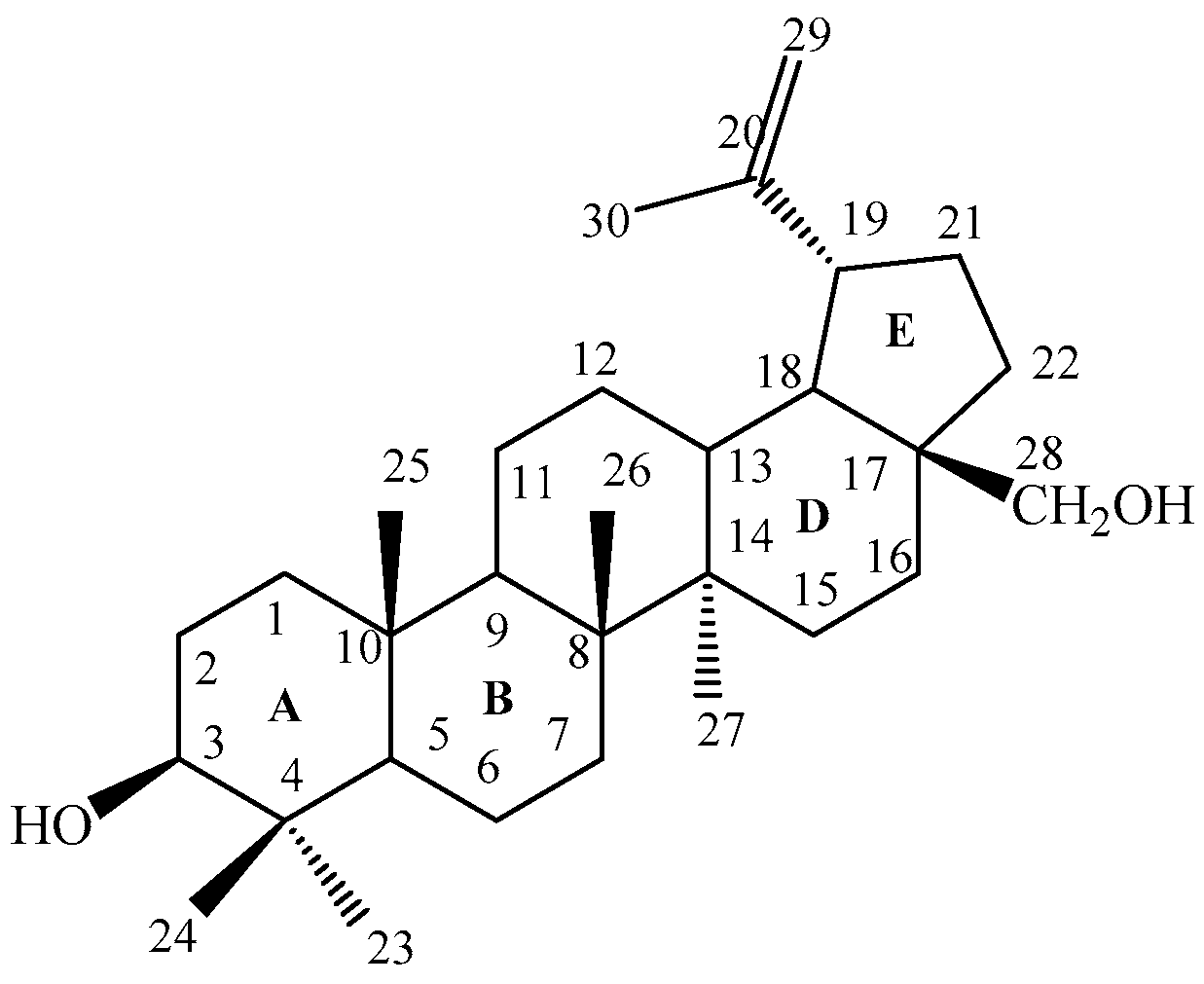

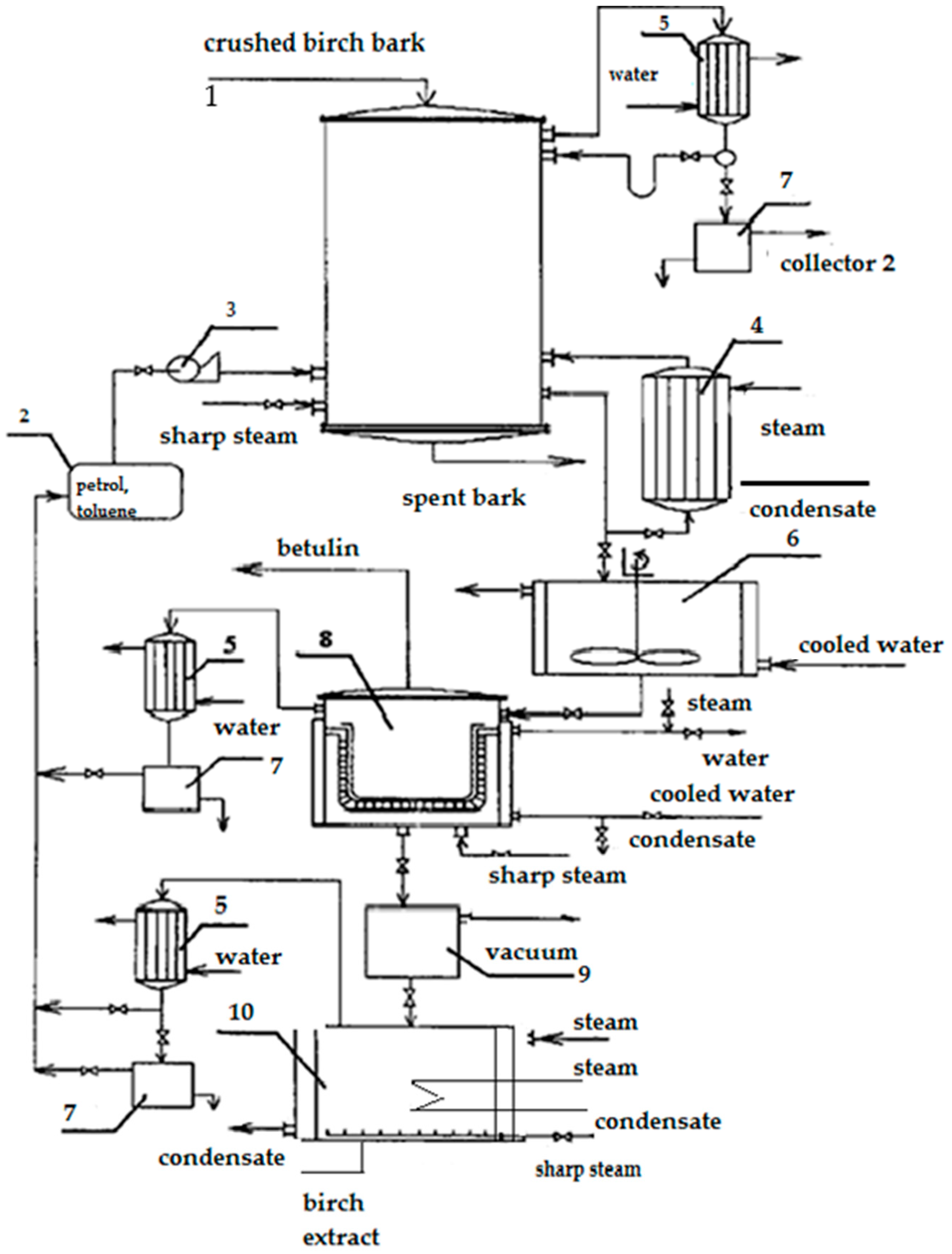
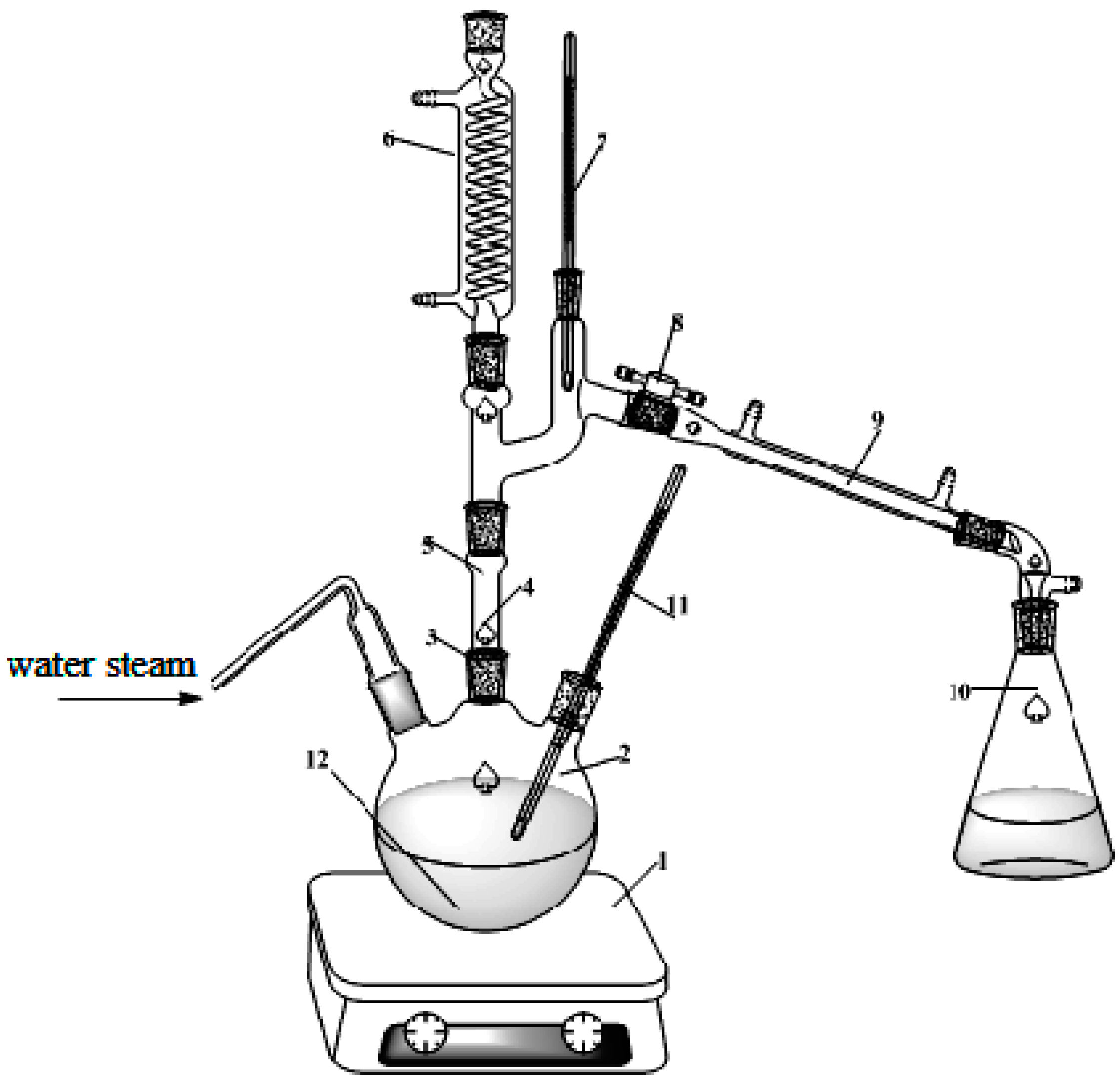
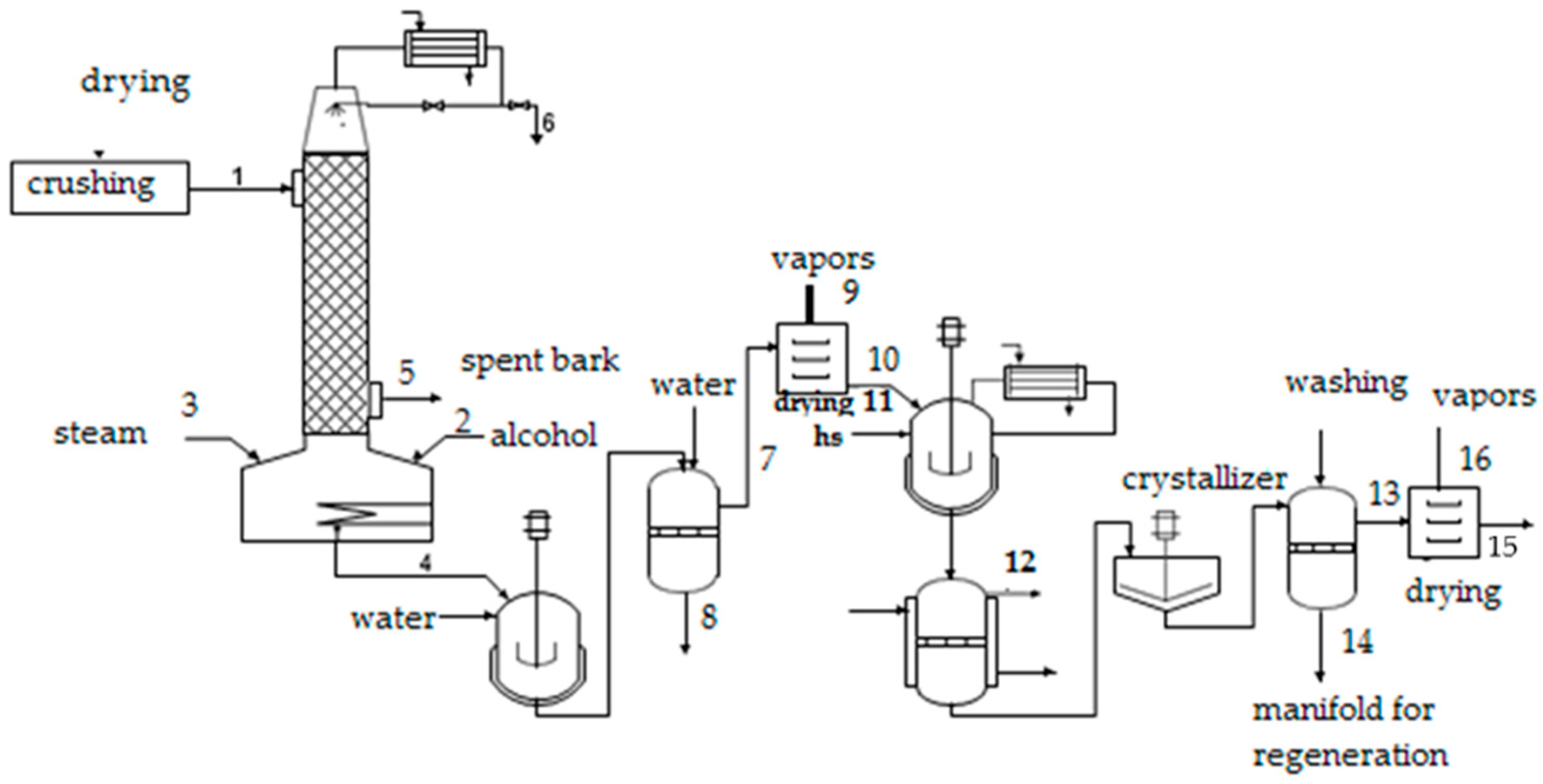

| Concentration NaOH, % | Duration of Birch Bark Hydrolysis with Butanol, h | ||
|---|---|---|---|
| 2 | 3 | 4 | |
| Quantitative Yield of Betulin, % | |||
| 15 | 2.9 | 4.9 | 2.5 |
| 20 | 6.5 | 10.9 | 5.9 |
| 25 | 5.9 | 7.6 | 5.5 |
| 30 | 3.9 | 5.2 | 2.7 |
| Concentration NaOH, % | Exposure Time of the Microwave Field, Min | |||
|---|---|---|---|---|
| 3 | 6 | 9 | 12 | |
| Quantitative Yield of Betulin, % | ||||
| 15 | 3.05 | 5.60 | 15.55 | 7.62 |
| 20 | 3.23 | 8.47 | 17.26 | 9.46 |
| 25 | 3.24 | 9.13 | 18.25 | 10.15 |
| Light Boiling Solvent | Proposed Method | Method [19] | |||
|---|---|---|---|---|---|
| Total Extract Yield, % (Betulin Content, %) | Betulin Yield Relative to the Bark, % | Total Extract Yield, % (Betulin Content, %) | Betulin Yield Relative to the Bark, % | ||
| 2 h | 2 h | 4 h | |||
| ethanol | 11.8 (65.8) | 7.76 | 8.19 | – | – |
| 2-propanol | 15.7 (36.6) | 5.75 | 7.69 | 20.6 (46.0) * | 9.48 |
| n-hexane | 6.0 (92.1) | 5.53 | 7.49 | 10.5 (90.1) ** | 9.46 |
| ethyl acetate | 18.3 (34.5) | 6.31 | 7.76 | 15.5 (60.0) * | 9.30 |
| Solvent | Extraction Process Temperature, °C | The First Recrystallization | The Second Recrystallization | ||||
|---|---|---|---|---|---|---|---|
| Betulin Fraction Yield, % | Betulin Content, % | Loss of Betulin, % | Betulin Fraction Yield, % | Betulin Content, % | Loss of Betulin, % | ||
| n-octane | 125 | 74.5 | 86.2 | 11.4 | 86.5 | 92.0 | 7.4 |
| n-nonane | 150 | 76.5 | 94.1 | 1.6 | 94.6 | 97.1 | 2.4 |
| n-decane | 174 | 75.2 | 95.4 | 1.8 | 95.5 | 98.3 | 1.3 |
| n-undecane | 195 | 75.3 | 91.2 | 5.2 | 90.1 | 94.1 | 6.8 |
| nefras C4–150/200 | 155 | 74.0 | 85.4 | 12.8 | 84.3 | 89.5 | 11.4 |
| kerosene TS-1 | 150 | 75.1 | 84.6 | 12.4 | 85.6 | 88.2 | 10.7 |
| Income | Outcome | ||||
|---|---|---|---|---|---|
| Component | Mass, g | Mass Fraction | Component | Mass, g | Mass Fraction |
| 1. Birch bark, incl.: | 1000.0 | 1.000 | 5. Spent birch bark, including: | 1673.9 | 1.000 |
| 1.1. Betulin | 153.0 | 0.153 | 5.1. Betulin | 24.5 | 0.015 |
| 1.2. Other extractable substances | 43.0 | 0.043 | 5.2. Other extractable substances | 6.9 | 0.004 |
| 1.3. Insoluble part | 786.0 | 0.786 | 5.3. Insoluble part | 770.3 | 0.460 |
| 1.4. Water | 18.0 | 0.018 | 5.4. Alcohol | 29.4 | 0.018 |
| 5.5. Water | 842.8 | 0.503 | |||
| 2. Rectified alcohol 86%, incl.: | 3000.0 | 1.000 | 6. Water–alcohol fraction, including: | 1364.2 | 1.000 |
| 2.1. Alcohol | 2580.0 | 0.860 | 6.1. Alcohol | 852.6 | 0.625 |
| 2.2. Water | 420.0 | 0.140 | 6.2. Water | 511.6 | 0.375 |
| 3. Steam | 1000.0 | 1.000 | 7. Solid residue, including: | 430.2 | 1.000 |
| 7.1. Betulin | 125.4 | 0.291 | |||
| 7.2. Other extractable | 35.3 | 0.082 | |||
| 7.3 Alcohol | 9.8 | 0.023 | |||
| 7.4. Water | 259.7 | 0.604 | |||
| Water for sediment | 2600.0 | 1.000 | 8. Manifold, including | 4371.8 | 1.000 |
| 8.1. Alcohol | 1636.6 | 0.374 | |||
| 8.2. Water | 2735.2 | 0.626 | |||
| Water for flushing | 400.0 | 1.000 | Total losses | 160.0 | 1.000 |
| Total: | 8000.0 | Total: | 8000 | ||
| Income | Outcome | ||||
|---|---|---|---|---|---|
| Mass Fraction | Component | Mass Fraction | Component | Mass, g | Mass Fraction |
| 7. Solid residue, incl.: | 430.2 | 1.000 | 9. Vapors, including: | 268.0 | 1.000 |
| 7.1. Betulin | 125.4 | 0.291 | 9.1. Alcohol | 9.6 | 0.036 |
| 7.2. Other extractable substances | 35.3 | 0.082 | 9.2. Water | 258.4 | 0.964 |
| 7.3. Alcohol | 9.8 | 0.023 | |||
| 7.4. Water | 259.7 | 0.604 | |||
| 10. Dry extract, incl.: | 160.7 | 1.000 | |||
| 10.1. Betulin | 124.8 | 0.777 | |||
| 10.2. Other extractable substances | 35.1 | 0.218 | |||
| 10.3. Water | 0.8 | 0.005 | |||
| Total losses | 1.5 | 1.000 | |||
| Total: | 430.2 | Total: | 430.2 | ||
| Income | Outcome | ||||
|---|---|---|---|---|---|
| Mass Fraction | Component | Mass Fraction | Component | Mass, g | Mass Fraction |
| 10. Dry extract, incl.: | 160.7 | 1.000 | 12. Solid residue, incl.: | 121.1 | 1.000 |
| 10.1. Betulin | 124.8 | 0.777 | 12.1. Betulin | 28.4 | 0.235 |
| 10.2. Other extractable | 12.2. Other extractable substances | 29.4 | 0.243 | ||
| substances | 35.1 | 0.218 | 12.3. Hydrocarbons | 63.3 | 0.522 |
| 10.3. Water | 0.8 | 0.005 | |||
| 11. Hydrocarbons for | 2000 | 1.000 | 13. Purified botulin, incl.: | 122.6 | 1.000 |
| recrystallization | 13.1. Betulin | 91.9 | 0.750 | ||
| 13.2. Other extractable substances | 1.5 | 0.012 | |||
| 13.3. Hydrocarbons | 29.2 | 0.238 | |||
| 12. Hydrocarbons for flushing | 300 | 1.000 | 14. Manifold, including | 2168.3 | 1.000 |
| 14.1. Betulin | 1.9 | 0.001 | |||
| 14.2. Other extractable substances | 3.4 | 0.002 | |||
| 14.3. Water | 0.7 | 0.000 | |||
| 14.4. Hydrocarbons | 2162.3 | 0.997 | |||
| Total losses | 48.7 | 1.000 | |||
| Total: | 2460.7 | Total: | 2460.7 | ||
| Income | Outcome | ||||
|---|---|---|---|---|---|
| Mass Fraction | Component | Mass Fraction | Component | Mass, g | Mass Fraction |
| 13. Purified botulin, incl.: | 122.6 | 1.000 | 15. Product, incl.: | 93.6 | 1.000 |
| 13.1. Betulin | 91.9 | 0.750 | 15.1. Betulin | 91.4 | 0.976 |
| 13.2. Other extractable substances | 1.5 | 0.012 | 15.2. Other extractable substances | 1.4 | 0.015 |
| 13.3. Hydrocarbons | 29.2 | 0.238 | 15.3. Hydrocarbons | 0.8 | 0.009 |
| 16. Hydrocarbon vapors | 27.1 | 1.000 | |||
| Total losses | 1.9 | 1.000 | |||
| Total: | 122.6 | Total: | 122.6 | ||
Publisher’s Note: MDPI stays neutral with regard to jurisdictional claims in published maps and institutional affiliations. |
© 2022 by the authors. Licensee MDPI, Basel, Switzerland. This article is an open access article distributed under the terms and conditions of the Creative Commons Attribution (CC BY) license (https://creativecommons.org/licenses/by/4.0/).
Share and Cite
Demets, O.V.; Takibayeva, A.T.; Kassenov, R.Z.; Aliyeva, M.R. Methods of Betulin Extraction from Birch Bark. Molecules 2022, 27, 3621. https://doi.org/10.3390/molecules27113621
Demets OV, Takibayeva AT, Kassenov RZ, Aliyeva MR. Methods of Betulin Extraction from Birch Bark. Molecules. 2022; 27(11):3621. https://doi.org/10.3390/molecules27113621
Chicago/Turabian StyleDemets, Olga V., Altynaray T. Takibayeva, Rymchan Z. Kassenov, and Madina R. Aliyeva. 2022. "Methods of Betulin Extraction from Birch Bark" Molecules 27, no. 11: 3621. https://doi.org/10.3390/molecules27113621
APA StyleDemets, O. V., Takibayeva, A. T., Kassenov, R. Z., & Aliyeva, M. R. (2022). Methods of Betulin Extraction from Birch Bark. Molecules, 27(11), 3621. https://doi.org/10.3390/molecules27113621





